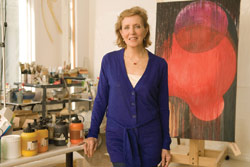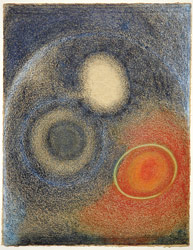Though Black Mountain College closed its doors more than 50 years ago, its legacy has flourished and evolved ever since. This weekend, scholars the world over will congregate in Asheville to observe the reverberations of its experimental and often courageous manifestos.

"Anywhere you go in the art world, if you mention Black Mountain College, everyone has heard of it," says UNCA philosophy professor Brian Butler, co-organizer of this weekend's Re-Viewing Black Mountain College conference. "Asheville tends to be parochial at times, and very focused on the current crafting and Appalachian traditions — but people don't realize that Black Mountain College has had an incredible international influence."
The international conference will unite BMC alumni, scholars, artists and aficionados — experts in all realms of the highly regarded school have been invited to talk on topics as disparate as sexuality, mathematics, astronomy and the avante garde. The work of notorious alums such as M.C. Richards, Josef Albers and John Cage will be discussed, as well as contemporary applications of the school's pioneering teaching methods.
The conference is the first of its kind and is Butler's brainchild. "I wanted to create exactly the kind of conference that I would want to go to myself," says Butler, who also serves on the board of the Black Mountain College Museum + Arts Center. The conference signals the beginning of an important alliance between that group and UNCA, which will be hosting almost all of the events. The weekend concludes with a tour of the Black Mountain College's Lake Eden Campus (now Camp Rockmont, site of a boy's summer camp and various festivals) on Sunday afternoon.

Founded in 1933 and operating on a spartan budget, Black Mountain College applied an interdisciplinary approach to education with a focus on the arts. The school attracted a legion of students and teachers who became renown for their experimental approaches to music, literature, visual arts and science. Bauhaus artists like Josef Albers came to Black Mountain after fleeing Nazi Germany, and unlikely creative collaborations have made the school legendary.
"It was a moment in time when radical experiments could happen — immigrants from Europe were bringing in new traditions," says Butler.
More than 50 speakers/performers will be participating in the conference, collected through a national call to the academic world for papers and writings pertaining to Black Mountain College. A healthy mix of artistic, experimental and academic symposiums have been organized which, in the spirit of the BMC, are open to spontaneous happenings. "One of the wonders of BMC is the combination of important scholars and people breaking basic rules," says Butler. "If the conference was purely academic, it wouldn't be in the proper spirit of BMC."
One such performer is Claire Elizabeth Barratt, whose motion sculptures challenge people's perspectives on predetermined arenas of performance. On Friday night Barratt will perform a version of Attack Of The Killer Stripey Tubes!!! Other performers include Vincent Wrenn, Mark Hanf and Marnie Muller. On Sunday, UNCA professor David Hopes' play This Paradise Apart: a theatrical of Black Mountain College will be staged.
Art across Astronomy: About the keynote speaker
A student of Black Mountain College during the 1950s, Dorothea Rockburne credits her mathematics teacher, Max Dehn, as having the most influence on her visual art. That's a testament to Black Mountain College's cross-disciplinary and experimental approach to education, which featured a strong liberal arts foundation based on artistic practice. Today Rockburne is a highly influential visual artist whose work is directly inspired by astronomy and quantum physics.
Rockburne will deliver the keynote speech of the Re-Viewing conference at 7 p.m. Saturday, Oct. 10.
During the '60s, Rockburne was involved in Judson Dance Theatre performances with artists such as Claes Oldenburg and Robert Rauschenberg. A recipient of a Guggenheim Fellowship and a NEA grant, she was inducted into the American Academy of Arts and Letters, Department of Art, in 2001.
Rockburne's Astronomy Drawings are currently on display at the Black Mountain College of Art Museum until November. The 14 abstract artworks are just a small sample of the artist's diverse and extensive oeuvre.
"A lot of people in Asheville know about BMC and are excited about the history," says Alice Sebrell, program director for BMCM + AC. "But maybe they are not aware of all the people around the world who are doing work around BMC, and are interested in the people and ideas from BMC."
Sessions like Educational Legacy will describe current models of teaching based on the BMC methods. In another, Query and Pursuit in Artistic Practice and Erudition, five artists from Florida to San Fransisco will talk about how BMC has inspired their work and creative processes.
"What's most interesting about this conference is the range of topics provided, from issues of Jewish politics to queer practices," Sebrell says. "We really want to represent the courage, the extent, and the depth of Black Mountain College."
who: BMC alumni and scholars, along with performances
what: Re-Viewing Black Mountain College
where: UNCA campus and Black Mountain College Museum + Arts Center, 56 Broadway
when: Friday, Oct. 9, to Sunday, Oct. 11. Cost is $10 per day or $15 for the weekend. (Full schedule at www.blackmountaincollege.org)



” . . . The work of notorious alums such as M.C. Richards, Josef Albers and John Cage will be discussed . . .”
no-to-ri-ous
–adjective
1. widely and unfavorably known: a notorious gambler.
adj. Known widely and usually unfavorably; infamous: a notorious gangster; a district notorious for vice.